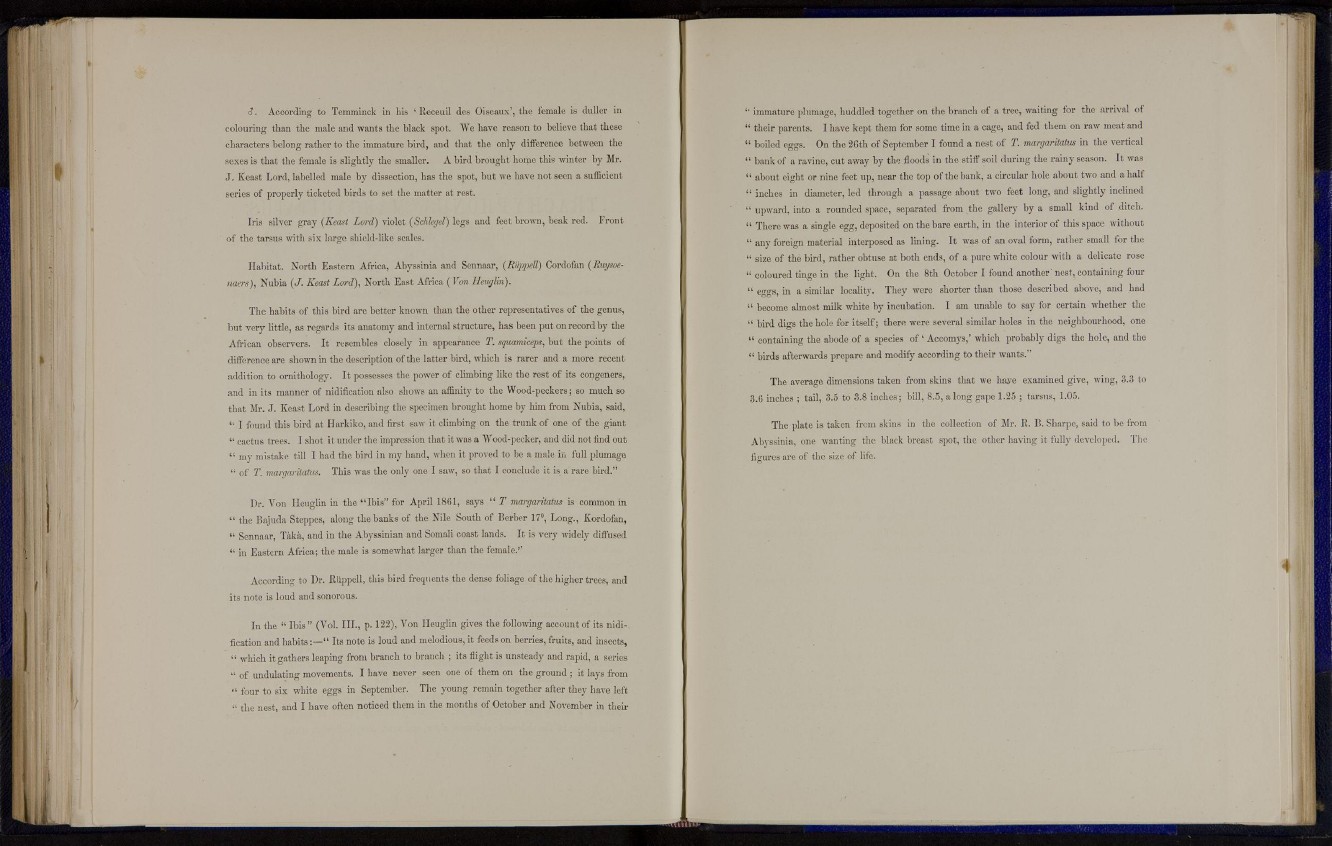
c?. According to Temminck in his ' lleceuil des Oiscaux', the female is duller in
colouring than the male and wants the black spot. We have reason to believe that these
characters belong rather to t h e immature bird, and that the only difference between the
sexes is t h a t the female i s s l i g h t ly the smaller. A bird brought home this winter by Mr.
J . Keast Lord, labelled male by dissection, has t he spot, but we have not seen a sufficient
series of properly ticketed birds to set the matter at rest.
I r i s silver gray (Keast Lord) violet (Schlegel) legs and feet brown, beak red. Front
of the tarsus with six large shield-like scales.
Habitat. North Eastern Africa, Abyssinia and Sennaar, (ffiippeU) Cordofan (Huysoenaers),
Nubia (J. Keast Lord), North East Africa ( Von Ileuglin).
The habits of this bird are better known than the other representatives of the genus,
but very little, as regards its anatomy and internal structure, has been put on record by t he
African observers. It resembles closely in appearance T. squamiceps, but the points of
difference are shown in t h e description of t h e latter bird, which is rarer and a more recent
addition to ornithology. It possesses the power of climbing like the rest of its congeners,
and in its manner of nidification also shows an affinity to the Wood-peckers; so much so
that Mr. J . Keast Lord in describing the specimen brought home by him from Nubia, said,
" I found this bird at Harkiko, and first saw it climbing on the t r u n k of one of the giant
" cactus trees. I shot it under the impression that it was a Wood-pecker, and did not find out
" my mistake till I had the bird in my hand, when it proved to be a male in full plumage
" of T. margaritatus. This was t he only one I saw, so that I conclude it is a rare bird."
Dr. Yon Ileuglin in the " I b i s " for April 1861, says " T margaritatus is common in
" the Bajuda Steppes, along the banks of the Nile South of Berber 17°, Long., Kordofan,
" Sennaar, Taka, and in the Abyssinian and Somali coast lands. It is very widely diffused
" in Eastern Africa; the male is somewhat larger than the female.''
According to Dr. Riippell, this bird frecpients the dense foliage of the higher trees, and
its note is loud and sonorous.
In the " I b i s " (Vol. I I I . , p. 122), Von Ileuglin gives the following account of its nidi-,
fication and h a b i t s : — " I t s n o t e is loud and melodious, it feeds on berries, fruits, and insects,
" which it gathers leaping from branch to branch ; its flight is unsteady and rapid, a series
" of undulating movements. I have never seen one of them on the ground ; it lays from
" four to six white eggs in September. The young remain together after the}- have left
" the nest, and I have often noticed them in t h e months of October and November in their
" immature plumage, huddled together on t h e branch of a tree, waiting for the arrival of
" their parents. I have kept them for some time in a cage, and fed them on r aw meat and
" boiled eggs. On the 26th of September I found a nest of T. margaritatus in the vertical
" bank of a ravine, cut away by the floods in the stiff soil during the r a i ny season. It was
" about eight or nine feet up, near the top of the bank, a circular hole about two and a half
" inches in diameter, led through a passage about two feet long, and slightly inclined
" upward, into a rounded space, separated from the gallery by a small kind of ditch.
" There was a single egg, deposited on t he bare earth, in the interior of this space without
" any foreign material interposed as lining. It was of an oval form, rather small for the
" size of the bird, rather obtuse at both ends, of a pure white colour with a delicate rose
" coloured tinge in the light. On the 8th October I found another'nest, containing four
" eggs, in a similar locality. They were shorter than those described above, and had
" become almost milk white by incubation. I am unable to say for certain whether the
" bird digs the hole for itself; there were several similar holes in the neighbourhood, one
" containing the abode of a species o f Accomys,' which probably digs the hole, and t he
" birds afterwards prepare and modify according to t h e i r wants."
The average dimensions taken from skins that we have examined give, wing, 3.3 to
3.6 inches ; tail, 3.5 to 3.8 inches; bill, 8.5, a l o n g gape 1.25 ; tarsus, 1.05.
The plate is taken from skins in the collection of Mr. R. B. Sharpe, said to be from
Abyssinia, one wanting the black breast spot, the other having it fully developed. The
figures are of the size of life.